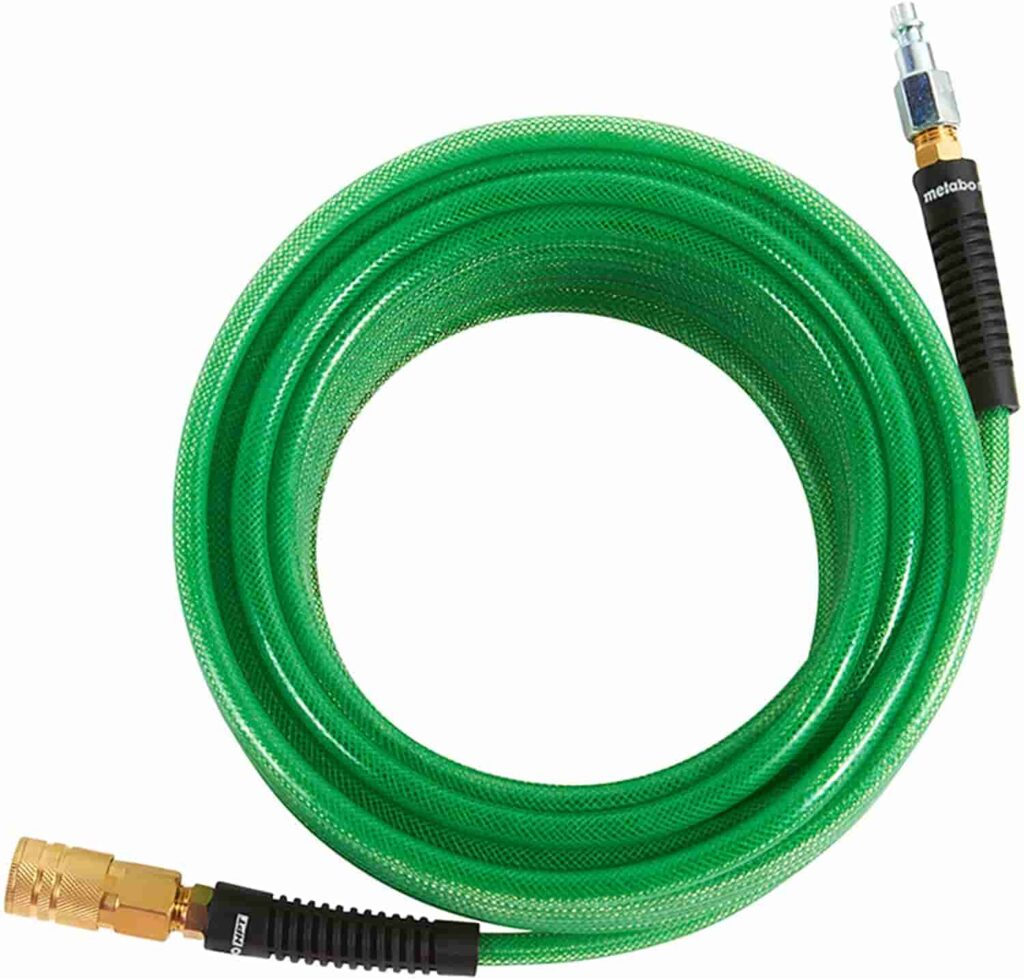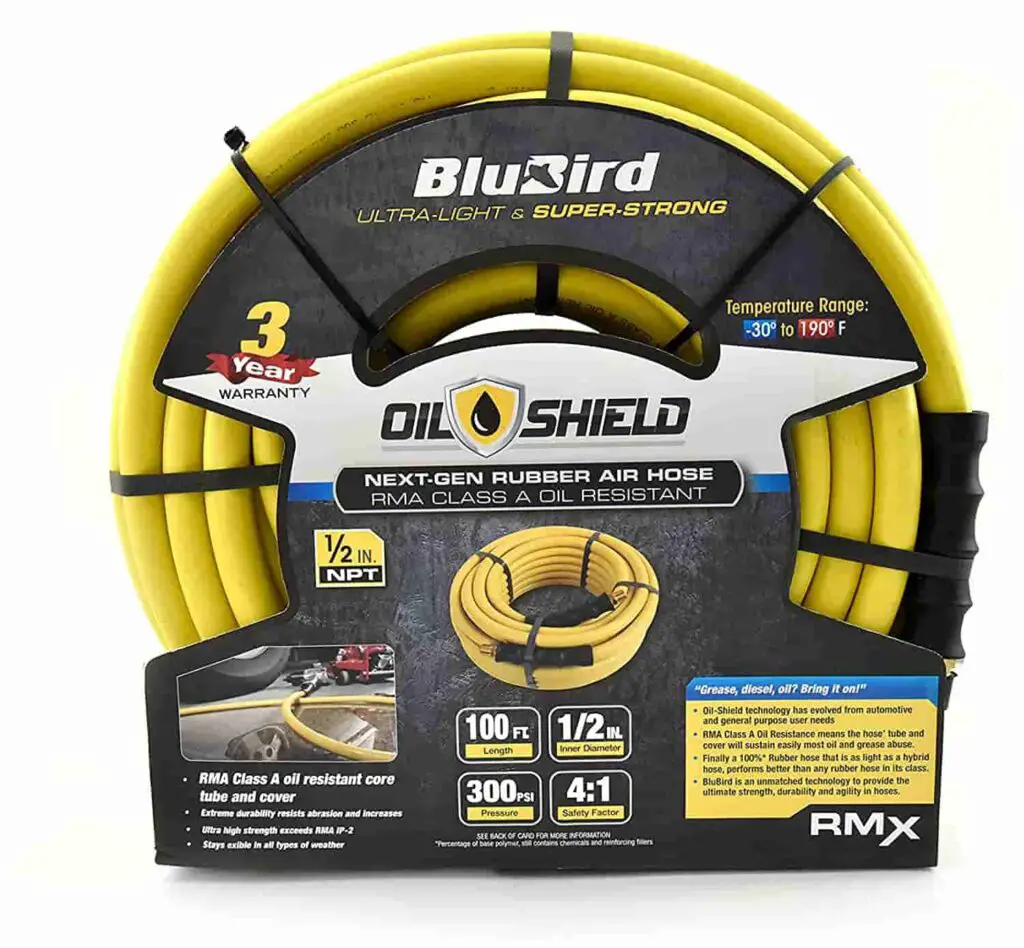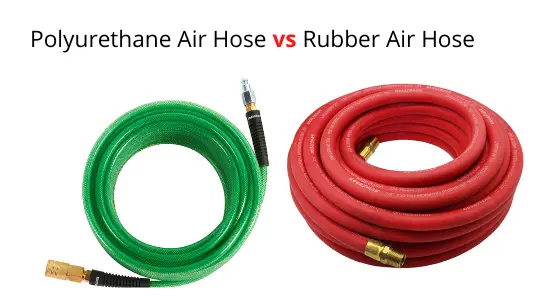Filling low tires & running air-powered tools will be easier and more efficient with an appropriate air hose for your compressor. On the other hand, a lousy hose might give you a headache ranging from not providing enough air to fighting you every time you roll and unroll it.
Today we will compare and contrast two well-known hose types: polyurethane vs rubber air hose. As a result, we can assist you in locating the finest one for you.
Polyurethane hoses are typically regarded as the most outstanding alternative for many applications. They are lighter and tend to stay flexible even in icy weather. On the other hand, rubber air hoses are made of flexible rubber that is heavy and has a long lifespan.
Following that, we will go through the factors that differentiate them. Let’s get started.
What are Polyurethane Air Hoses?
Polyurethane, often known as PUR, PU, or TPU, combines the most remarkable qualities of plastic and rubber. It has good elongation values (stretchability) like rubber and more excellent abrasion resistance than PVC.
Polyurethane is inherently flexible and does not require the addition of additives to maintain its flexural qualities.
Polyurethane hoses outperform PVC and TPR hoses in a wide range of industrial and commercial applications. Because of its production possibilities, it is also the most practical hose.
Pros
- Polyurethane hoses are wear and chemical resistant.
- It has improved vacuum and pressure ratings, as well as low-temperature flexibility.
Cons
- It’s a little stickier than others and may stick with itself.
What are Rubber Air Hoses?
These air hoses, which are often made from a combination of polyurethane, PVC, and rubber, are incredibly sturdy and flexible, allowing you to work on a variety of tasks with ease.
Rubber air hoses are typically used with air compressors to operate cylinders, valves, tools, or fill tires.
Rubber air hoses are the heaviest sorts of compressor hoses on the marketplace and are inherently abrasion-resistant. Rubber air hoses are also resistant to kinking and need little maintenance, making them suited for moderate to heavy use.
Pros
- Rubber hose is a smoother, more malleable material.
- Regular to heavily loaded use in agricultural, industrial, professional, and domestic settings.
Cons
- The rubber hose is more prone to kinking and is a little heavier than others.
See More: Silicone vs Rubber Vacuum Hose
A Quick Comparison Chart: Polyurethane vs Rubber Air Hose
| Basis of Comparison | Polyurethane Air Hose | Rubber Air Hose |
| Material | Rubber, PVC, and Plastic | Flexible and Durable Rubber |
| Weight | Light | Heavier than others |
| Durability | Resistant to solvents but long-lasting. | It lies smoothly, resists twisting and coiling, and is abrasion-resistant. |
| Price | 0.4$ to 0.7$ per ft | 0.5$ to 0.8$ per ft |
| Dimension | .25 inches | .25 inches |
| Corrosion Resistance | High | High |
| Temperature Tolerance | -20℃ to 60℃ | -40°C to 75°C |
| Pressure resistance | 200 – 300 PSI | 250 – 300 PSI |
| Reusability | Excellent | Excellent |
Polyurethane vs Rubber Air Hose: Detailed key Differences
Your needs and personal interests determine the best hose for you. The section below compares the performance of Polyurethane and Rubber air hoses in various capacities.
- Flexibility
Rubber hoses are smoother than polyurethane hoses. And, for a neat appearance, the rubber hose will loop back out onto the hose extremely evenly. Again, the texture of the urethane hose is much more rubbery.
It has a certain degree of springing or bounce to it. This is beneficial in kink resistance but not in producing a gorgeous smooth loop on the hose. The polyurethane hose may be coiled up and stored on a reel.
An image-perfect-looking wrap, on the other hand, is more challenging to accomplish than the rubber hose. It would also be advantageous to use longer lengths of urethane hose with a reel.
Similarly, it will be a complex process to loop a polyurethane hose into a round coil on the surface. Even in frigid temperatures, both hoses remain highly flexible.
- Non-Marking
Because the polyurethane cover is completely non-marking, you won’t have to worry about leaving markings on pristine surfaces. Because the rubber hose is softer, it may leave stains on surfaces or a tiny black residue on your hands after reeling it in.
- Durability
The polyurethane hose’s outer shell is constructed of the same substance as the roller skate wheels. This is the most durable substance we’ve discovered.
When the PU hose is pulled across a harsh or sharp surface (as well as a rock) or to the corner of a stone, the degree of wear is reduced, and the rubber hose’s outer shell is softer and more easily torn.
- Ratings for Temperature and Pressure
The temperature range of the poly hose is -40°F to 165°F, whereas the average temp of the rubber hose is -40°F to 190°F. In terms of pressure, the poly hose can withstand up to 160 PSI. The rubber hose has a PSI rating of 150.
- Kink-Resistance
Rubber hoses, like traditional garden hoses, are significantly more prone to kinking and retaining a ‘kinking memory,’ which occurs whenever a hose appears to memorize where it tensioned and then has a natural inclination to kink more quickly in that identical area over and over.
The rubbery nature of the urethane hose allows it to ‘flip’ from a kink instead of collapsing into one. Polyurethane also has no kinking memory.
- Fittings
The brass fittings on the Eley urethane hose are lead-free and crush-proof, but the brass connections on standard rubber hoses are not. Because the ELEY urethane hoses are lead-free, you may use them with drinking water.
ELEY connectors have a ⅝” hole for optimal flow. While rubber hoses may have an ID of ⅝”, exterior crimp fittings have tighter gaps and a lower flow rate.
- Water Safety
Polyurethane garden hoses from Eley are “Drinking Water Safe.” The rubber hose, on the other hand, is not.
Best Polyurethane Air Hoses:
- Hromee 1/4-Inch x 50 Feet Polyurethane Air Hose

Hromee polyurethane recoil hose is made of polyurethane and has extraordinary all-weather flexibility. It exceeds the nylon hose in terms of strength and flexibility.
This item has an inner diameter of 1/4″ x 50′. It has a 50-foot hose length. It also has a maximum operating pressure of 300 PSI. Hromme also included a 1/4″ NPT brass coupler and an I/M type steel plug that was already attached.
- Metabo HPT Professional Grade Polyurethane Air Hose

This hose is compact than PVC hose and performs flexibly in a variety of adverse weather conditions. Metabo HPT also has a large selection of professional-grade power tools and woodworking supplies.
This component is spiral reinforced for added strength and has a three-to-one burst ratio to sustain 300 PSI. Furthermore, its bend restrictors extend its lifespan and keep it versatile even in freezing temperatures. Finally, it has a crimped-on compression ring as well as a 6-ball brass fitting.
Best Rubber Air Hoses:
- Oil Shield – The Most Flexible Class A Rubber Air Hose

The BluBird Oil-Shield combines the original BluBird’s lightweight and highly robust qualities with a hose that satisfies the RMA Class A oil-resistance requirement. It is 40% lighter and far more resilient than comparable hoses in its class.
It has a constant pressure of 300PSI from -50F to 200F and a burst pressure of 1200PSI. It also includes 1/4″ Brass M-NPT end fittings. As a result, this item is ideal for work environments where oil, fuel, or grease spills worry.
- Goodyear 12709 Red Rubber Air Hose

The sturdy Goodyear hose comes with a 1/2-inch hose diameter per 50 feet. Furthermore, this rubber hose can be perfect for stapler guns, pneumatic equipment, air compressors, and lawn sprayers. It also has heat-resistant, oil, and weather-resistant exterior covering.
It has a maximum working pressure of 250 PSI and a burst pressure of 1070 PSI. The average temp is -40°F to 190°F.
Check Also: PVC vs Rubber vs Polyurethane Air Hose
Final Verdict
Finally, we can claim that you’ve learned a lot about polyurethane vs rubber air hose and are capable of selecting any of the best air hoses for your needs.
Once again, the best-compressed air hose is the one that is appropriate for the work. You can use a polyurethane air hose for regular or portable work. However, if you want to undertake above or elevated work or move the hose about in confined spaces, we recommend using a rubber hose.
At last, before making a buying selection, evaluate your budget and tolerance for entanglement.

